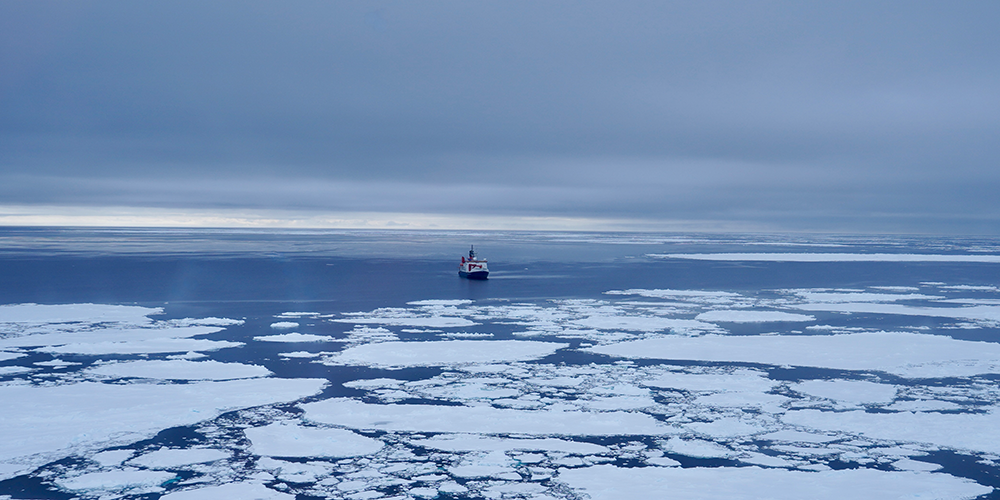Microplastic particles can be found in the most remote ocean regions on Earth. In Antarctica, pollution levels surpass previous estimates, according to a recent study with contributions from the University of Basel.

The researchers were out in the southern Arctic Ocean on the research vessel Polarstern and took water samples, which they analyzed for the smallest microplastic particles. Image Credit: Clara Leistenschneider, University of Basel
This is not the first study on microplastics in Antarctica that researchers from the University of Basel and the Alfred-Wegener Institute (AWI) have conducted. However, results from an expedition in the spring of 2021 reveal that environmental contamination from these microscopic plastic particles is a larger concern in the remote Weddell Sea than previously believed.
Of the 17 seawater samples taken, all of them revealed a higher concentration of microplastics compared to the samples taken for the previous studies.
The reason for this is the type of sampling we conducted.
Clara Leistenschneider, Study Lead Author and Doctoral Student, Department of Environmental Sciences, University of Basel
The present study concentrated on particles ranging from 11 to 500 micrometers. Researchers gathered these by pumping water into tanks, then filtering and analyzing it with infrared spectroscopy. Earlier research in the area primarily retrieved microplastic particles from the ocean using fine nets with a mesh size of approximately 300 micrometers, allowing smaller particles to slip through these plankton nets.
The findings of the recent study revealed that 98.3 percent of the plastic particles found in the water were smaller than 300 micrometers, indicating that they had not been captured in previous samples.
“Pollution in the Antarctic Ocean goes far beyond what was reported in past studies,” Leistenschneider noted.
The study was recently published in the journal Science of the Total Environment.
What Role Do Ocean Currents Play?
Individual samples were contaminated to varying extents. The offshore samples taken north of the continental slope and the Antarctic Slope Current had the highest concentrations of microplastics.
The reasons behind this are not entirely clear. It is possible that the ice that forms along the coast holds the microscopic plastic particles and only releases them back into the sea when it melts. Ocean currents could also be involved.
They might work like a barrier, reducing water exchange between the north and south.
Gunnar Gerdts, Postdoctoral Researcher, Alfred Wegener Institute Helmholtz Centre for Polar and Marine Research
Undoubtedly, ocean currents play a crucial role and remain a focal point for numerous unresolved inquiries in this domain. Presently, researchers have solely analyzed water samples from the ocean surface without delving into lower depths. This limitation primarily arises from the constrained time allocated during ship expeditions for sample collection, as well as from equipment lacking sufficient pumping capacity.
Leistenschneider added, “It would nonetheless be revealing to analyze such data, since the deep currents differ greatly from the surface currents and thermohaline circulation leads to exchange with water masses from northern regions.”
Furthermore, it remains unclear how microplastics initially reach the Weddell Sea and whether they eventually leave the region. The powerful Antarctic Circumpolar Current, which runs around the Antarctic Ocean at a latitude of around 60° south, could hinder their departure.
The researchers also remain unable to conclusively pinpoint the origin of the microplastics. Potential sources encompass research stations on land and regional ship traffic associated with tourism, fishing, and research sectors. Conversely, it is plausible that atmospheric transport or ocean currents facilitate the transportation of microplastics from other locations to Antarctica.
Research Leads to Awareness
Clara Leistenschneider's next objective is to analyze the sediment samples collected during the same expedition. This endeavor aims to shed light on the accumulation of microplastics on the seafloor, a critical habitat for unique and delicate organisms, including the Antarctic icefish (Bovichtidae).
The rise in tourism within the Antarctic Ocean raises concerns about a potential escalation in pollution levels in the future. This could exacerbate environmental degradation and disrupt the delicate balance of the food chain.
However, Leistenschneider remains cautiously optimistic.
She stated, “Research on the topic has dramatically increased awareness in recent years of the problems that microplastics cause for the environment and all living organisms.”
While acknowledging the absence of a singular solution, she highlights the concerted efforts of stakeholders worldwide who are diligently working to deepen their understanding of the issue and pioneer innovative strategies aimed at mitigating plastic pollution.
She concluded, “Every individual who engages in environmentally-conscious behavior can bring about positive change.”
Journal Reference:
Leistenschneider, C., et. al. (2024) Unveiling high concentrations of small microplastics (11–500 μm) in surface water samples from the southern Weddell Sea off Antarctica. Science of the Total Environment. doi:10.1016/j.scitotenv.2024.172124